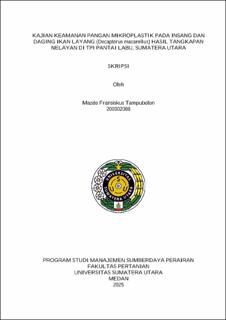| dc.contributor.advisor | Dewinta, Astrid Fauzia | |
| dc.contributor.author | Tampubolon, Mazdo Fransiskus | |
| dc.date.accessioned | 2025-03-25T02:53:12Z | |
| dc.date.available | 2025-03-25T02:53:12Z | |
| dc.date.issued | 2025 | |
| dc.identifier.uri | https://repositori.usu.ac.id/handle/123456789/102485 | |
| dc.description.abstract | Indonesia is one of the largest contributors of plastic waste pollution in the
world, but the level of microplastics in its waters is still very small compared to the
United States and China. Mackerel are included in the small pelagic fish caught by
fishermen at the Labu Beach TPI. The presence of microplastics in the waters can
directly enter the body of the mackerel through the mouth during the feeding
process, while indirectly it can come from prey organisms that have been
contaminated with microplastics previously or from the respiration process
through the gills. The aim of this study was to determine the abundance and
characteristics of microplastics contained in the gills of the Mackerel
(D. macarellus), knowing the estimation of microplastics in the human body on the
safety risk of consuming Mackerel (D. macarellus), knowing the safety and quality
of the Mackerel (D. macarellus) caught at the TPI Pantai Labu, North Sumatra.
This research was conducted from September to October 2024, based on the
catches of fishermen at the Labu Beach TPI. The analysis of fish samples used was
FTIR, Histology and BSLT. The results of the study showed that the types of
microplastics that had been identified in the gills of mackerel at TPI Pantai Labu
consisted of 4 types, namely fiber, film, pellets and fragments with the most
microplastics found in the form of pellets amounting to 945 particles. The estimated
microplastics in the human body that consumes mackerel (D. macarellus) is 3,81
particles/year. Food safety of Mackerel (D. macarellus) is safe for consumption.
Based on FTIR tests, fish gills and meat contain bonds from Polypropylene (PP),
Polystyrene (PS), Polyethylene (PE), Polyvinyl chloride (PVC) and Polyamide
(Nylon) polymers. Furthermore, based on histological tests, it is known that the
intercellular muscle cells of the fish meat become loose, which is caused by
microplastics entering the fish's body through the digestive organs, which can
cause oxidative stress and inflammation, which damages the structure of muscle
cells. | en_US |
| dc.language.iso | id | en_US |
| dc.publisher | Universitas Sumatera Utara | en_US |
| dc.subject | Mackerel (Decapterus macarellus) | en_US |
| dc.subject | Microplastics | en_US |
| dc.subject | FTIR (Fourier Transform Infra Red) | en_US |
| dc.subject | Histology | en_US |
| dc.subject | BSLT (Brine Shrimp Lethality Test) | en_US |
| dc.title | Kajian Keamanan Pangan Mikroplastik pada Insang dan Daging Ikan Layang (Decapterus Macarellus) Hasil Tangkapan Nelayan di TPI Pantai Labu, Sumatera Utara | en_US |
| dc.title.alternative | Study of Microplastic for Food Safety in Gills and Meat of Mackerel (Decapterus macarellus) Caught by Fishermen at TPI Pantai Labu, North Sumatra | en_US |
| dc.type | Thesis | en_US |
| dc.identifier.nim | NIM200302088 | |
| dc.identifier.nidn | NIDN0010018802 | |
| dc.identifier.kodeprodi | KODEPRODI54242#Manajemen Sumber Daya Perairan | |
| dc.description.pages | 73 Pages | en_US |
| dc.description.type | Skripsi Sarjana | en_US |
| dc.subject.sdgs | SDGs 14. Life Below Water | en_US |


